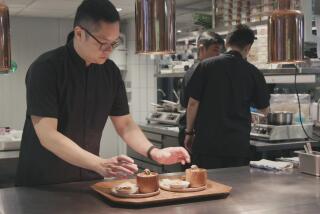Farmers Markets: Look for Page and Lee mandarins
- Share via
Mandarins at their best are the noblest of citrus, with intense, complex aromatics and fascinating varietal identities. Two clementine-tangelo crosses prized for their rich flavor, Page and Lee, are now in peak season and well worth searching out. Page long been a favorite at farmers markets, and recently commercial growers have caught on and planted them on a larger scale. Its half-sister, Lee, is rare in California but arguably has even more extraordinary flavor.
Page originated in Florida in 1942 as a cross of Algerian clementine and Minneola tangelo and was introduced by the U.S. Department of Agriculture in 1963. That makes it three-quarters mandarin and one-quarter grapefruit, but it most resembles a small orange, with a deep orange rind and firm flesh, and a distinctive areole, a circular furrow at the blossom end. In Florida it was marketed as an early, high-flavored orange and was fairly common in the 1970s and ‘80s; but its small-to-medium size didn’t quite fit that category, and today there are fewer than 100 acres in the Sunshine State, much of which goes to gift-fruit shippers.
Page is not a typical mandarin, since it’s round, not flattish, and only moderately easy to peel. Early in the season, the best way to eat it is to slice it into sections; later on, peeling is an option. Usually Page is seedless when it’s grown in solid blocks, but it can be seedy when raised near other pollinizing citrus. It became popular in California with home garden and specialty growers chiefly because of its superb quality — like a sweet, juicy orange with a touch of wild mandarin spice.
For Pages grown in the San Joaquin Valley, the season generally starts in late December and runs through January, or as late as March for farmers market vendors. Maturity is a week or so early this year, and Balderama Farms of Orosi has already started selling excellent Pages at the Crenshaw, Virginia Park, Echo Park and Santa Monica Wednesday farmers markets. Rancho Padre offers Pages grown in Exeter at Burbank, Pasadena (Saturday) and Venice. Ken Lee of Reedley will start this week at Torrance (Saturday and Tuesday), Hollywood, South Pasadena and La Cienega. Mike Agnew does a particularly fine job with his Pages, which he’ll have at Hollywood starting Jan. 6. (In coastal Southern California Page ripens a month later and stores well on the trees, so the harvest runs from February to May for growers like Juan Garcia of Fallbrook.)
Recently, following a boom in plantings of clementines and W. Murcotts, a few commercial growers in the San Joaquin Valley found that Page filled a harvest niche between these varieties and planted several hundred acres of it. Some brands market Page interchangeably with the more common varieties; although it’s a different style of fruit, consumers should have no reason to complain about the flavor.
Page’s half-sibling, Lee, is usually seedy and has a thin, yellow-orange rind that is not particularly easy to peel, two strikes against it commercially, in a market ruled by seedless easy-peelers. It wouldn’t be worth a second thought except for its unique flavor, with complex aromatics, and a noticeable tinge of grapefruit, which is at least partly explained by its parentage.
The Florida breeders who created Page, F.E. Gardner and J. Bellows, came up with Lee at the same time, in 1942, by crossing Algerian clementine and Orlando tangelo. (Orlando, like Minneola, is a hybrid of Dancy tangerine and Duncan grapefruit, but it’s smaller, lighter in color and more grapefruit-like in flavor.) Lee, which is sometimes regarded as a tangelo, is lower in acidity than Page, but it “gets aromatic high notes that Page can’t get to,” notes Quentin Roe, the leading Florida grower of mandarins for fresh market, who calls Lee his favorite mandarin for flavor. Lee has proved more consistent in size than Page in Florida, where it is grown on an estimated 400 to 500 acres, he adds.
Lee never became commercially important in California, but Tony Thacher of Friend’s Ranches, an indefatigable explorer of unusual mandarin varieties, has 60 producing trees in Ojai and just planted another 60 last year. His season runs from late November to mid-January at the Hollywood and Ojai markets, and at Santa Monica on Wednesdays.
Why is Thacher doubling down on a commercially obsolete variety?
“It’s intensely perfumed, like a citrus version of Sauvignon Blanc,” he says. “Customers demand them, because it’s all about the flavor.”
More to Read
Eat your way across L.A.
Get our weekly Tasting Notes newsletter for reviews, news and more.
You may occasionally receive promotional content from the Los Angeles Times.










